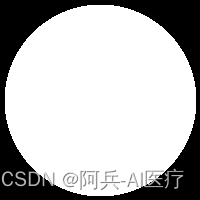介绍如何访问像素,以及根据图像内存创建ITK图像类
灰度图像访问像素
通常创建一个灰度图像,展示如何访问像素
//new a 3D image based on unsigned short pixel
typedef itk::Image<unsigned short, 3> ImageTpye;
ImageTpye::Pointer image = ImageTpye::New();
//define image type index
ImageTpye::IndexType start;
start[0] = 0; //index in x axis
start[1] = 0; //index in y axis
start[2] = 0; //index in z axis
//define image size
ImageTpye::SizeType size;
size[0] = 200;
size[1] = 200;
size[2] = 1;
//define image region
ImageTpye::RegionType region;
region.SetSize(size);
region.SetIndex(start);
//initialize image
image->SetRegions(region);
image->Allocate();
//define pixel variable
ImageTpye::PixelType initialValue = 0;
image->FillBuffer(initialValue);
ImageTpye::IndexType pixelIndex;
for (int i = 10; i < 50; i++) {
for (int j = 10; j < 50; j++) {
pixelIndex[0] = i;
pixelIndex[1] = j;
pixelIndex[2] = 0;
image->SetPixel(pixelIndex, 255);
}
}
彩色图像访问像素
通常创建一个彩色图像,展示如何访问像素
//new a 3D color image based on unsigned char pixel
typedef itk::RGBPixel< unsigned char > PixelType;
typedef itk::Image<PixelType, 3> ImageTpye;
ImageTpye::Pointer image = ImageTpye::New();
//define image type index
ImageTpye::IndexType start;
start[0] = 0; //index in x axis
start[1] = 0; //index in y axis
start[2] = 0; //index in z axis
//define image size
ImageTpye::SizeType size;
size[0] = 200;
size[1] = 200;
size[2] = 1;
//define image region
ImageTpye::RegionType region;
region.SetSize(size);
region.SetIndex(start);
//initialize image
image->SetRegions(region);
image->Allocate();
//define pixel variable
ImageTpye::PixelType initialValue ;
PixelType::ValueType red = initialValue.GetRed();//提取红色部分
PixelType::ValueType green = initialValue.GetGreen();//提取绿色部分
PixelType::ValueType blue = initialValue.GetBlue();//提取蓝色部分
std::cout << "Red = "
<< itk::NumericTraits<PixelType::ValueType>::PrintType(red)
<< std::endl;
std::cout << "Green = "
<< itk::NumericTraits<PixelType::ValueType>::PrintType(green)
<< std::endl;
std::cout << "Blue = "
<< itk::NumericTraits<PixelType::ValueType>::PrintType(blue)
<< std::endl << std::endl;
image->FillBuffer(initialValue);
initialValue.SetRed(255);
ImageTpye::IndexType pixelIndex;
for (int i = 10; i < 50; i++) {
for (int j = 10; j < 50; j++) {
pixelIndex[0] = i;
pixelIndex[1] = j;
pixelIndex[2] = 0;
image->SetPixel(pixelIndex, initialValue);
}
}
通过内存创建图像
/*选择数据类型来表示图像像素。我们假设内存的外部内存块使用同样的数据类
型来表示像素*/
typedef unsigned char PixelType;
const unsigned int Dimension = 3;
typedef itk::Image< PixelType, Dimension > ImageType;
//ImportImageFilter 类型的实例化
typedef itk::ImportImageFilter< PixelType, Dimension > ImportFilterType;
//使用 New( ) 方法创建一个滤镜对象importFilter然后指向一个智能指针
ImportFilterType::Pointer importFilter = ImportFilterType::New();
/*滤镜要求用户指定图像的大小来作为输出,使用 SetRgion() 方法即可做到。图像大小必
须和当前调用的缓冲器的像素变量的数字相匹配*/
ImportFilterType::SizeType size;
size[0] = 200; // size along X
size[1] = 200; // size along Y
size[2] = 200; // size along Z
ImportFilterType::IndexType start;
start.Fill(0);
ImportFilterType::RegionType region;
region.SetIndex(start);
region.SetSize(size);
importFilter->SetRegion(region);
//使用 SetOrigin() 方法来指定输出图像的原点
const itk::SpacePrecisionType origin[Dimension] = { 0.0, 0.0, 0.0 };
importFilter->SetOrigin(origin);
//使用 SetSpacing( ) 方法来传递输出图像的间距
const itk::SpacePrecisionType spacing[Dimension] = { 1.0, 1.0, 1.0 };
importFilter->SetSpacing(spacing);
/*现在我们分配包含像素数据的内存块传递信息到 ImportImageFilter 。注意:我们使用与
SetRegion() 方法指定的大小完全相同的尺寸。在实际应用中,你可以使用一个代表图像的
不同的数据结构从一些其他的类库中得到这个缓冲器。*/
const unsigned int numberOfPixels = size[0] * size[1] * size[2];
PixelType *localBuffer = new PixelType[numberOfPixels];
const double radius = 80.0;
/*这里可以用一个 binary sphere 来填充这个缓冲器。这里我们像 C 或 FOTTRAN 编程语
言一样使用简单的 for () 循环。注意: ITK 在其访问像素的内部编码中不能使用 for () 循环。
使用支持处理 n 维图像的 itk::ImageIterators 来代替执行所以的像素访问任务。*/
const double radius2 = radius * radius * 3;
PixelType *it = localBuffer + (size[2] - size[2]) * size[0] * size[1];
for (unsigned int z = 0; z < size[2]; z++)
{
const double dz = static_cast<double>(z)
- static_cast<double>(size[2]) / 2.0;
for (unsigned int y = 0; y < size[1]; y++)
{
const double dy = static_cast<double>(y)
- static_cast<double>(size[1]) / 2.0;
for (unsigned int x = 0; x < size[0]; x++)
{
const double dx = static_cast<double>(x)
- static_cast<double>(size[0]) / 2.0;
const double d2 = dx * dx + dy * dy + dz * dz;
*it++ = (d2 < radius2) ? 255 : 0;
}
}
}
/* 缓冲器在 SetImportPointer() 作用下传递到 ImportImageFilter 。注意这种方法的最后一个
问题是当内存不再使用时指定谁来释放内存。当返回值为假时,表示当调用析构时
ImportImageFilter 并没有释放缓冲器;另一方面,当返回值是真时,表示允许释放析构的输
入滤镜上的内存块。
由于 ImportImageFilter 释放了适当的内存块, C++ new() 操作就可以调用这些内存。用
其他分配内存机制分配的内存,比如 C 中的 malloc 和 calloc ,将不会由 ImportImageFilter
来释放适当的内存。换句话说,编程应用者就需要确保仅仅给 ImportImageFilter 命令来释放
C++ 新操作分配内存。*/
const bool importImageFilterWillOwnTheBuffer = true;
importFilter->SetImportPointer(localBuffer, numberOfPixels,
importImageFilterWillOwnTheBuffer);
importFilter->Update();
typedef itk::ImageFileWriter< ImageType > WriterType;
WriterType::Pointer writer = WriterType::New();
writer->SetFileName("test.png");
/*最后,我们将这个滤镜的输出连到一个管道上。为简便起见,我们在这里只使用一个
writer ,当然其他任何滤镜都可以:*/
writer->SetInput(importFilter->GetOutput());
try
{
writer->Update();
}
catch (itk::ExceptionObject & exp)
{
std::cerr << "Exception caught !" << std::endl;
std::cerr << exp << std::endl;
}









 这篇博客介绍了如何在ITK(Insight Toolkit)中访问和设置灰度图像及彩色图像的像素。首先展示了创建3D灰度图像并修改特定区域像素值的过程,接着演示了创建3D彩色图像并填充像素的方法。此外,还详细阐述了如何通过外部内存创建图像,包括定义图像大小、原点、间距,以及使用ImportImageFilter从内存块导入像素数据并保存为图像文件。
这篇博客介绍了如何在ITK(Insight Toolkit)中访问和设置灰度图像及彩色图像的像素。首先展示了创建3D灰度图像并修改特定区域像素值的过程,接着演示了创建3D彩色图像并填充像素的方法。此外,还详细阐述了如何通过外部内存创建图像,包括定义图像大小、原点、间距,以及使用ImportImageFilter从内存块导入像素数据并保存为图像文件。















 4956
4956

 被折叠的 条评论
为什么被折叠?
被折叠的 条评论
为什么被折叠?








